Guidance for Pre-Feasibility Studies Under the EE Incentive Scheme for energy intensive industries in Vietnam Hanoi, 2024
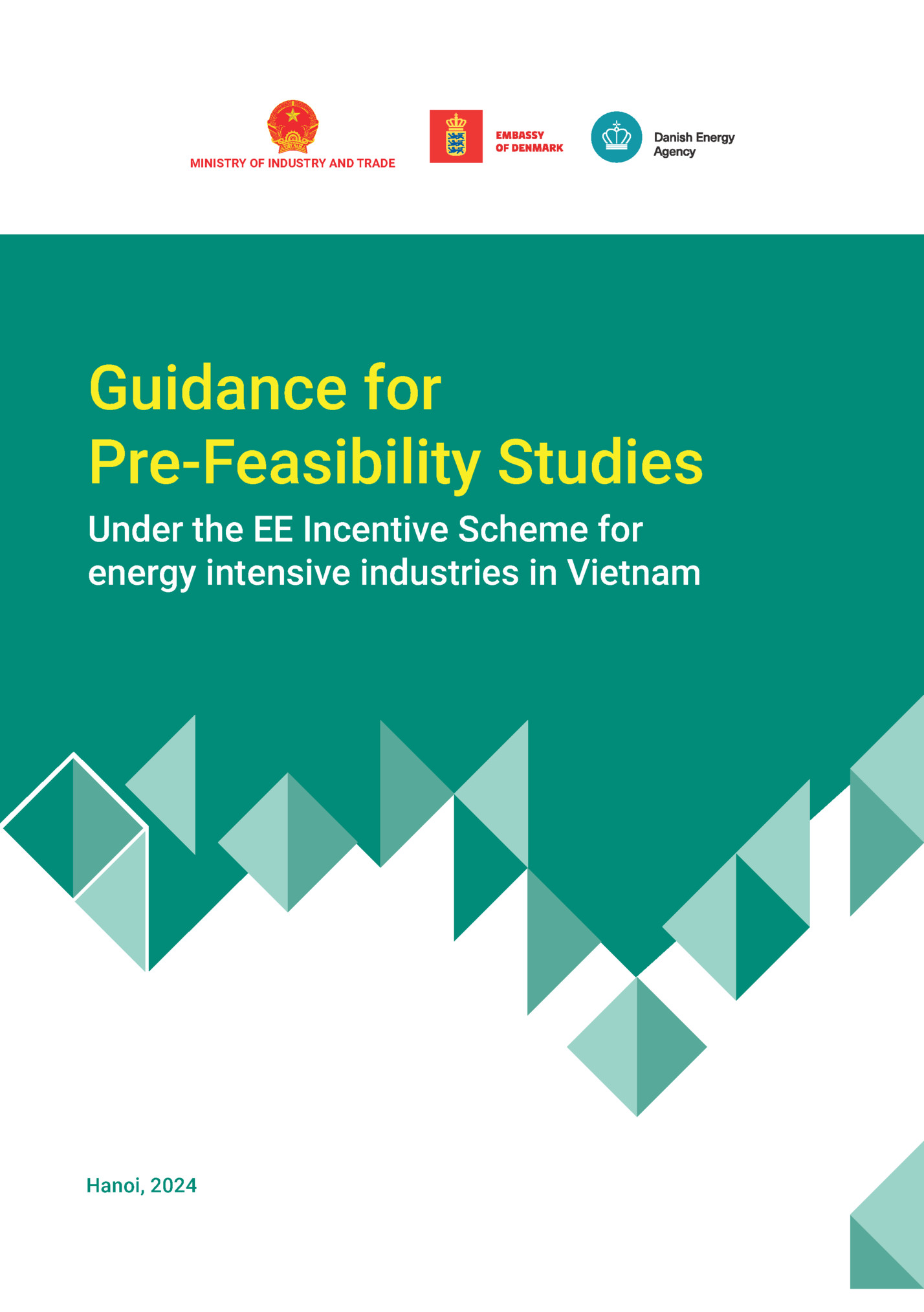
Pre-Feasibility Studies Under the EE Incentive Scheme for energy intensive industries in Vietnam Hanoi, 2024
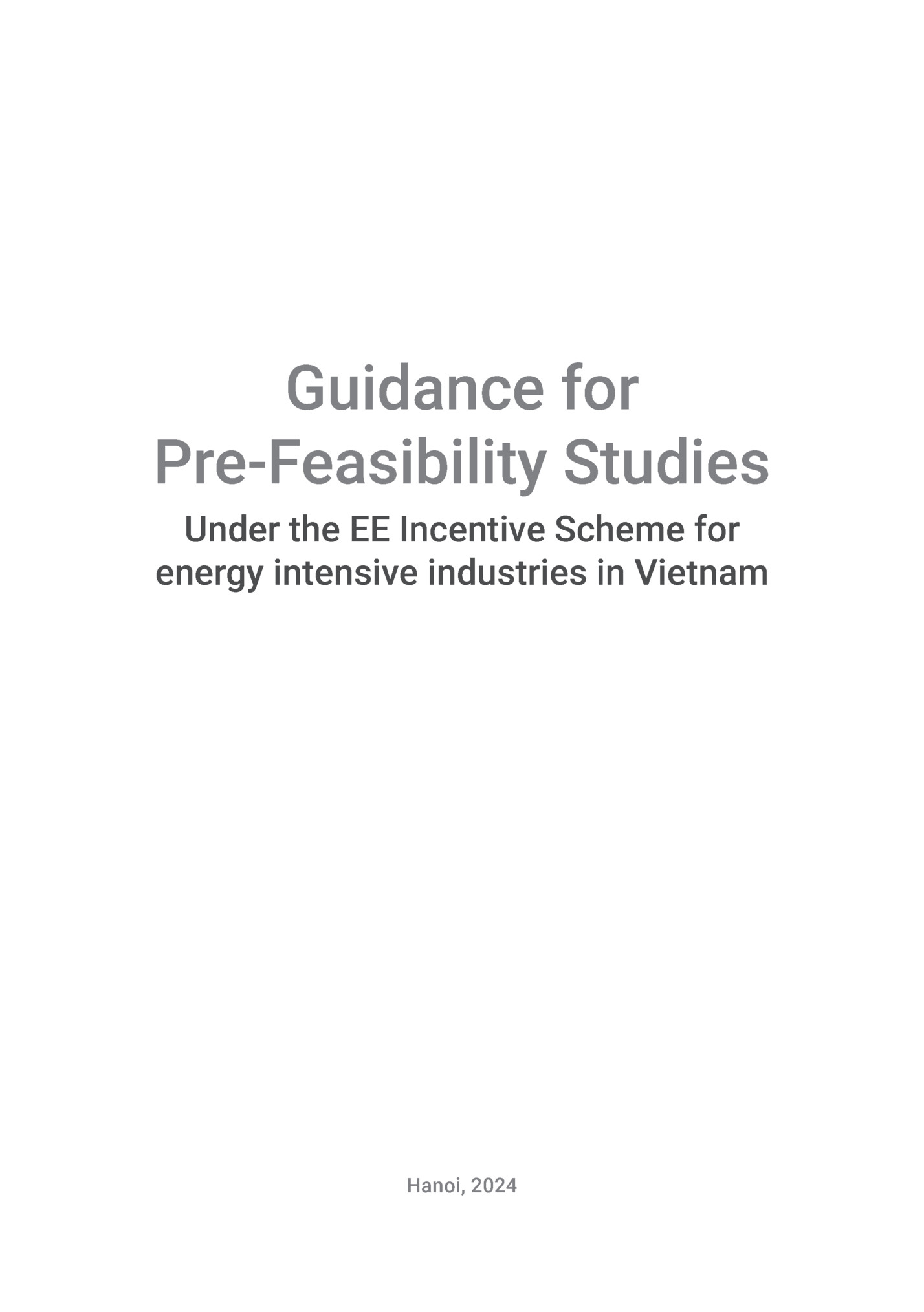
The Vietnam - Denmark Energy Partnership Program 2020-2025 (DEPP3) is a technical assistance project funded by the Danish Government and jointly implemented by the Ministry of Industry and Trade in collaboration with the Danish Energy Agency. The program aims to assist Vietnam in developing a low-carbon roadmap for the energy sector in accordance with the Nationally Determined Contributions (NDCs) and the Paris Agreement on climate change. Within the framework of Component 3: “Low Carbon Development in Industry”, led by the Department of Energy Efficiency and Sustainable Development (Ministry of Industry and Trade), one of the key activities is the implementation of the Voluntary Agreement on Energy Efficiency in Energy Intensive Industries (the VAS Program). To support businesses and organizations in their participation in the VAS Program, the Ministry of Industry and Trade is honored to introduce a series of documents, including: • Energy Audit Guideline • Pre-feasibility Study Guideline • Feasibility Study Guideline • Loan Application Guidance The documents have been compiled for three primary target groups: industrial enterprises, energy auditing firms, and commercial banks interested in providing funding for energy efficiency projects. The materials are presented in a clear, practical format and are applicable to a diverse range of enterprises. The Ministry of Industry and Trade wishes to express its sincere appreciation for the substantial collaboration of the Danish Energy Agency, the Danish Embassy in Vietnam, and the invaluable contributions of both domestic and international experts throughout the document preparation process. The Ministry of Industry and Trade hopes that these materials will serve as a valuable resource for supporting domestic enterprises and consulting firms in their participation in the Voluntary Agreement Program and implementing energy efficiency projects.
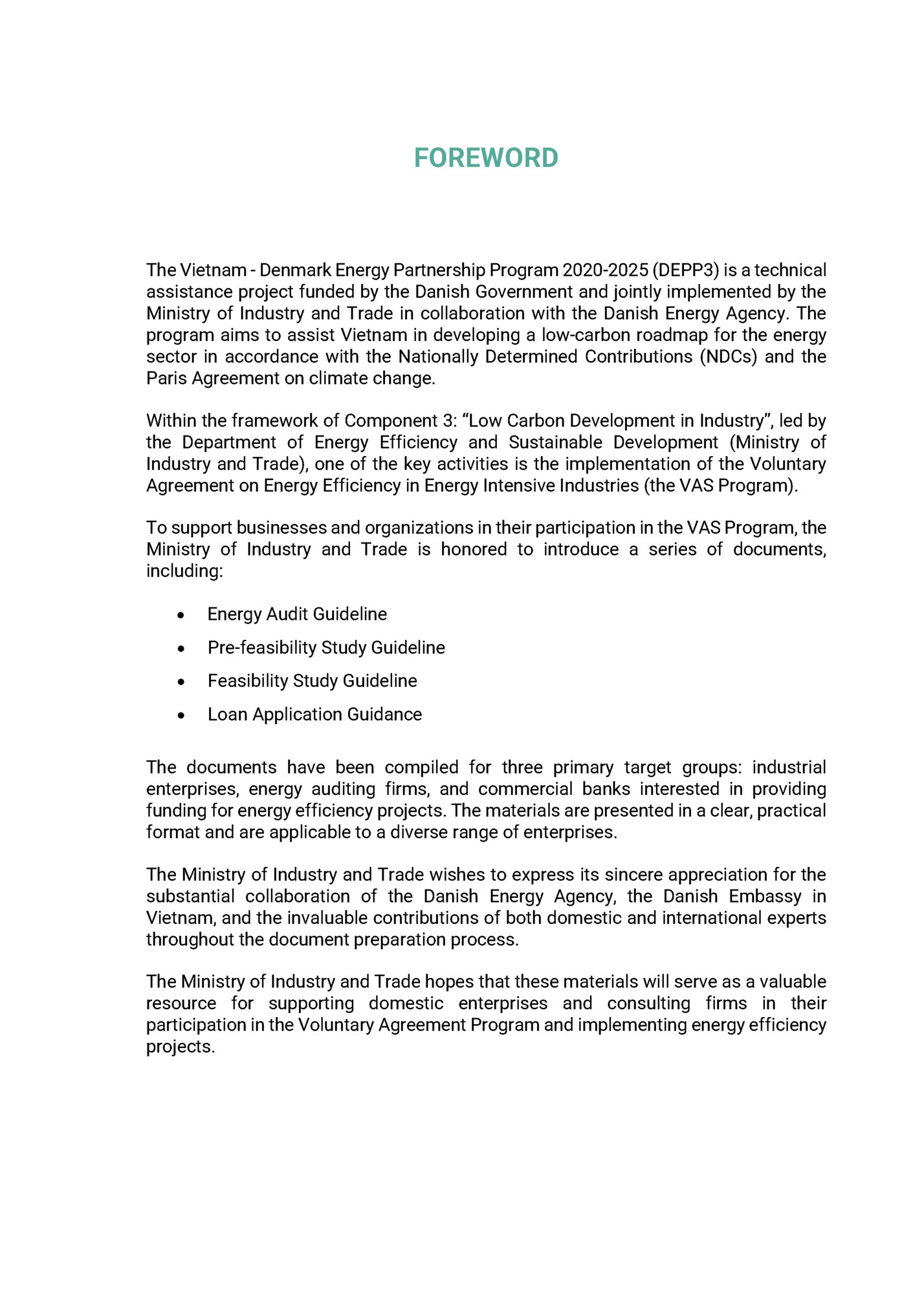
Draft Guidance for Pre-Feasibility Studies under the EE Incentive Scheme for energy intensive industries in Vietnam Date: 2024.04.23 Project no: DE3 Output 2 (2023) Version: 3 Prepared by: PMP Prepared for: DEA & EESD QA by: FMH, JGHV, ERE Approved by: - VIEGAND MAAGØE A/S ZEALAND Head office Nørre Søgade 35 DK 1370 Copenhagen K Denmark T +45 33 34 90 00 info@viegandmaagoe.dk www.viegandmaagoe.dk CBR 29688834 JUTLAND Samsøvej 31 DK 8382 Hinnerup
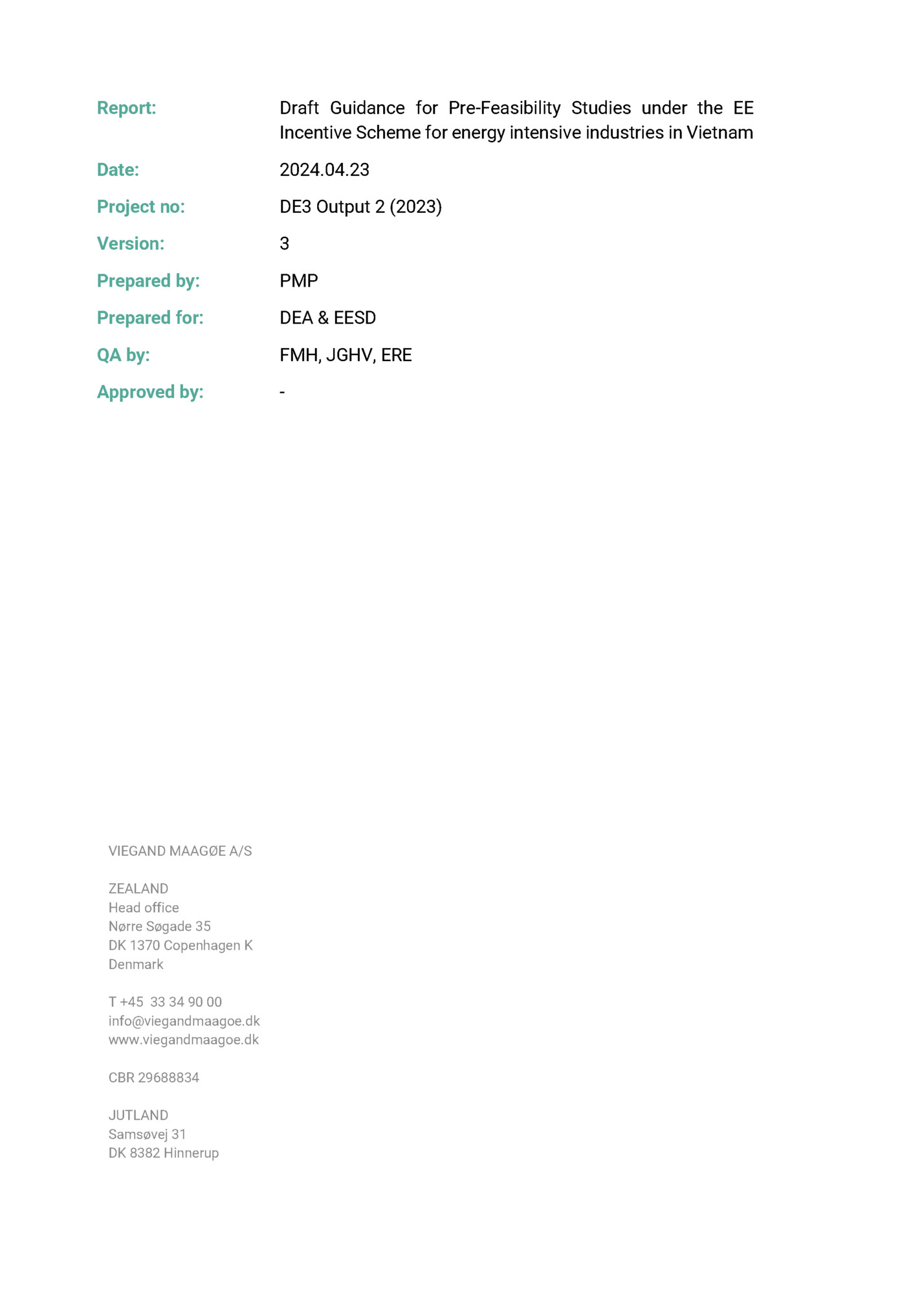
This document is a guideline to develop pre-feasibility studies for industrial Energy Efficiency (EE) projects in Vietnam. The guideline is prepared in the context of the Energy Partnership Program between Vietnam and Denmark and. The pre-feasibility study is a step towards a final management decision regarding allocating funds for investments – a work sequence that usually comprises several phases: 1. An initial energy audit or screening identifies potentials to improve energy efficiency and/or reduce CO2-emissions from the company’s operations. Separate detailed guidelines for energy audits, feasibility studies and for application for loans for EE projects have been developed and can be downloaded from the DEPP3 webpage. 2. The purpose of a pre-feasibility study is to define relevant alternative technical solutions to obtain a certain energy efficiency potential, and to specify each solution in more detail with regards to financial, environmental and other aspects, such as legal aspects, impacts on production output and product quality etc. Based on such comprehensive assessment, the management will be in a position to decide on a preferred solution, which can then be further detailed in a feasibility study. The pre-feasibility report is usually for internal purposes only, but for large investment projects, the report might be very useful for a dialogue with possible investors as well as authorities already at this stage. 3. A feasibility study is carried out to precisely define the preferred solution with regards to all major uncertainties remaining from the pre-feasibility study, for example in terms of scope, technical solution, investments (CAPEX) and operating costs (OPEX) or other. Based on the feasibility study, the management of the company can finally decide on allocating funds for carrying out the project (Final Investment Decision – FID). A guideline to feasibility studies can be downloaded from the DEPP3 webpage. 4. Next step would be a tendering phase. In the tender document, the approved solution is defined into an even greater detail to ensure the desired features and quality of the proposals provided. 5. A contracting phase, where contracts for installations and related works are signed and performance guarantees for the planned project are defined and settled in the contract(s). 6. Project implementation and commissioning. The guideline is structured according to proposed structure of the pre-feasibility study report. The pre-feasibility guideline is sought to be aligned with the current regulation e.g., the construction law 2020, article 53 and 54. Guidance for Pre-Feasibility Studies |3
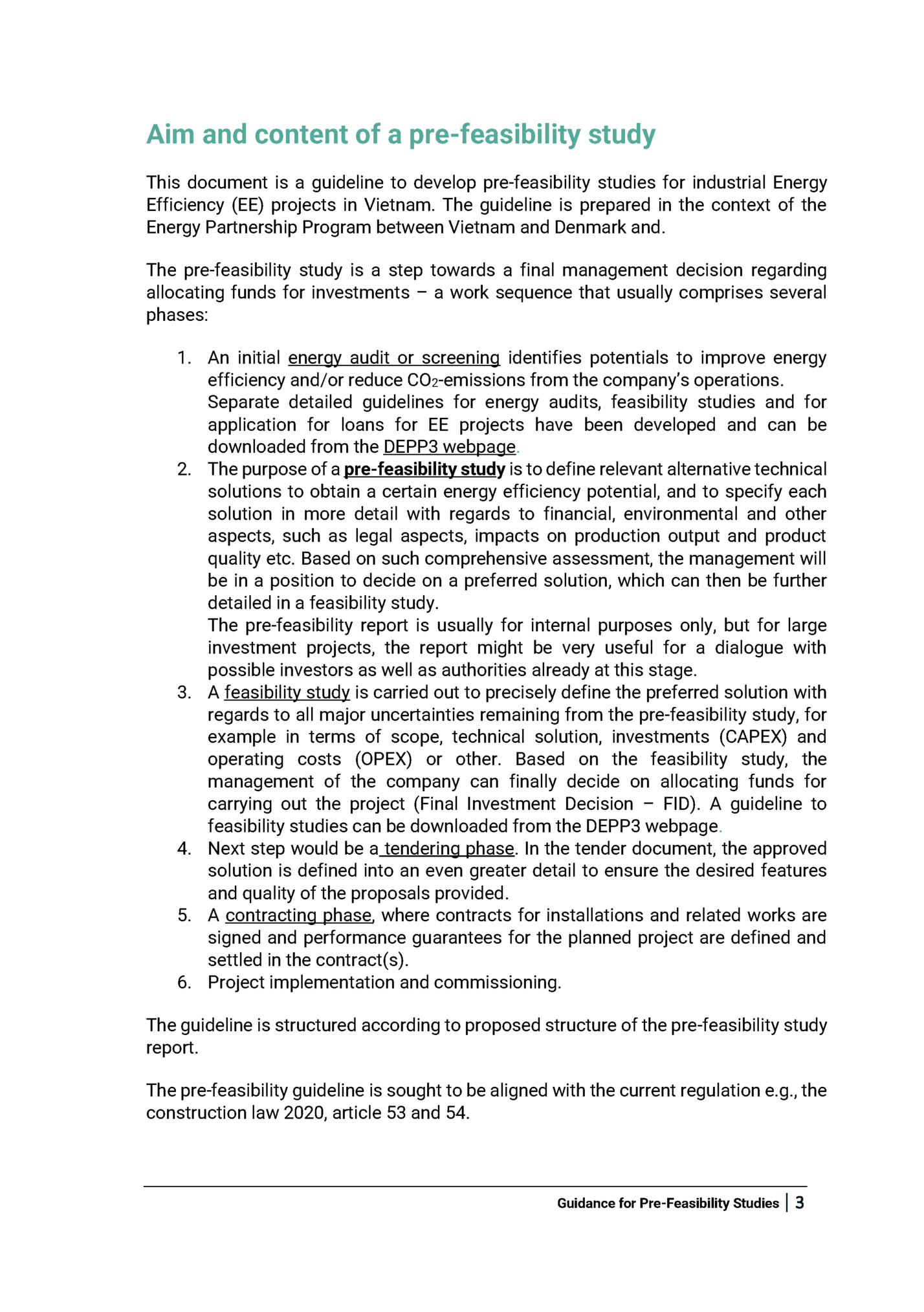
1 Summary ............................................................................................................. 5 2 Background, purpose and scope of project ...................................................... 5 2.1 Background ......................................................................................................... 5 3 Analysis of baseline project............................................................................... 8 3.1 Purpose of project .............................................................................................. 8 3.2 Scope of the project ........................................................................................... 9 3.3 Design basis for the project ............................................................................... 9 4 Solution description .........................................................................................12 4.1 Solution principle ..............................................................................................12 4.2 Key equipment ..................................................................................................13 4.3 Assessment of necessary investments (CAPEX) ..........................................14 4.4 Energy savings..................................................................................................15 4.5 Financial analysis of the solution ....................................................................17 4.6 Other non-energy benefits ...............................................................................17 5 Alternative solution strategies.........................................................................18 5.1 Other project development questions.............................................................19 6 Financing strategy ............................................................................................20 7 Conclusions on preferred solution and further steps… .........................................20 Guidance for Pre-Feasibility Studies |4

Summary The summary shall report main findings and conclusions from the pre-feasibility (pre-fs) study of particular relevance to the enterprise management and possible external stakeholders. The summary should outline the alternative solutions investigated and summarize the features of each solution, including all the characteristics of major importance for the decision-making on any next steps. The section should provide a strategic overview of the results of the individual sections of the report, including key financial indicators as well as other important impacts, such as: - Impacts on the competitiveness of the enterprise in the market, for example as a result of a reduced environmental footprint of the production process - Impacts on the pollution levels in the local environment - Impacts on working environment The summary must also make clear the level of risks and uncertainty of the findings. If for example the project involves a novel application of a specific technology or if there is a considerable uncertainty around investment costs and similar, such information should be provided in the summary. Based on this information, the summary should provide a recommendation for selection of preferred solution as well as next steps. Especially when developing complex projects, the pre-fs may still leave several issues open regarding the preferred solution. These should be clearly listed, and if relevant, a feasibility study could be recommended in order to resolve these issues. 2 Background, purpose and scope of project As basis for the pre-feasibility study, the background, specific purpose and scope of the project shall be described. 2.1 Background The background section of the pre-fs should include at least the following elements: Guidance for Pre-Feasibility Studies |5
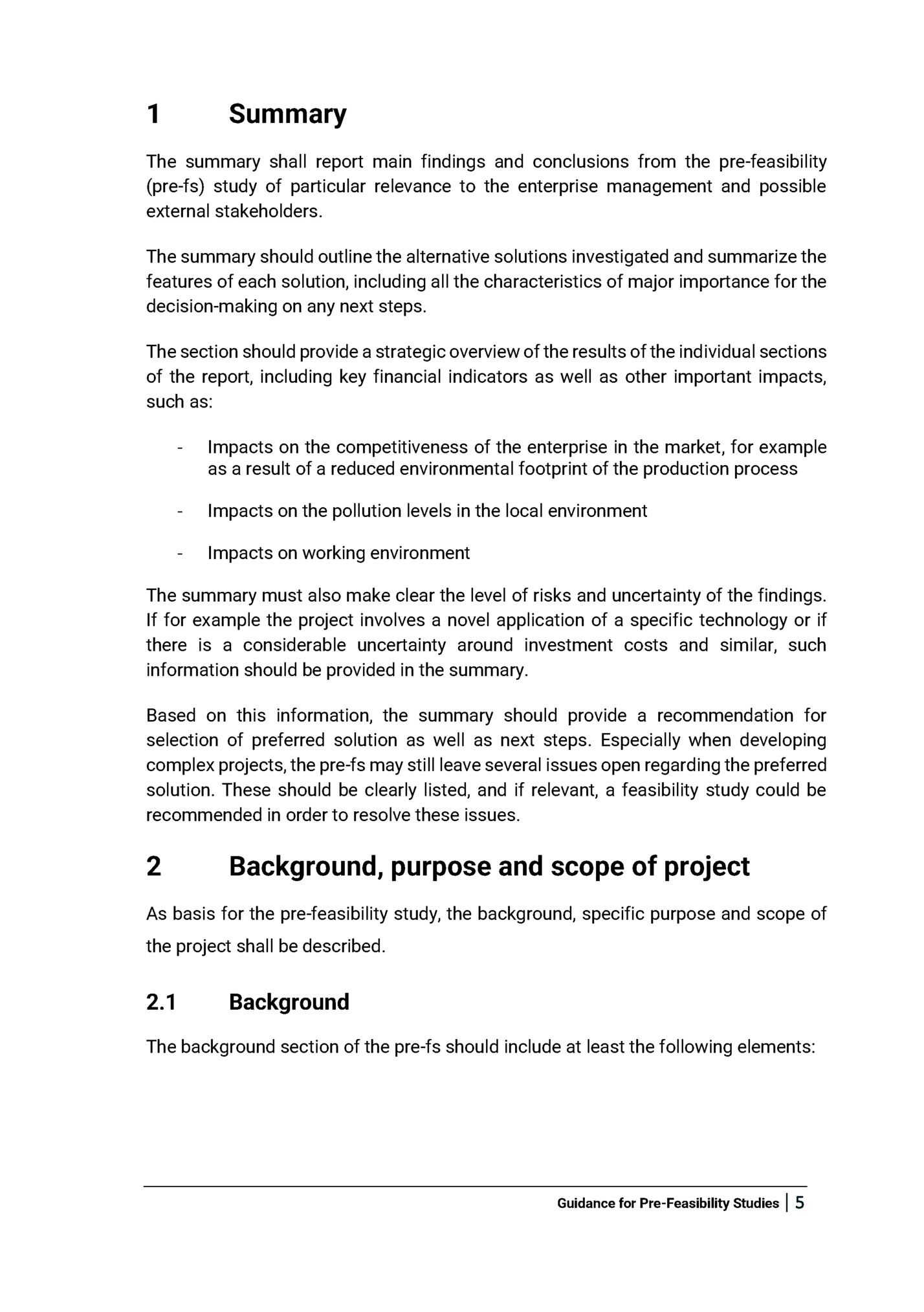
Justification of the study This section should briefly summarize the background for the decision to undertake the pre-fs, for example findings of a preceding energy audit or screening etc. • Existing situation Brief introduction to the part of the enterprise relevant to the Pre-fs, including: - Process diagram(s), - Technologies used (observations regarding age, efficiency etc.) - Operation schedule (number of hours per day/week/year) - Availability of the existing system: Planned and unplanned outages - Possible issues with capacity, quality of product output, working environment or others. • Expected enterprise developments relevant to the project The section should outline the development plans of the industrial enterprise. Such plans could have an important impact on the feasibility of a given energy efficiency project. If for example the enterprise plans to expand the production capacity to an extent where the capacity of the current boiler will not be sufficient, it might not be relevant to upgrade the existing boiler, even if it is very inefficient. On the other hand, replacement of an existing boiler with a new, bigger and more efficient would provide two benefits: increased capacity and reduced energy supply costs. This would increase the attractiveness of such investment significantly. The chapter should also briefly explain the policy and priority given to energy efficiency. • Outline of relevant alternative interventions In many cases, a given set of objectives, including increased energy efficiency, may be obtained on various different ways. For example, a drier system can be optimized in several different ways. First step should be to consider whether the steam consumption could be reduced. This could be achieved from such measures as improved process control, insulation of hot surfaces, or use of waste heat from other sources, such as air compressors. In some cases, the use of steam can be efficiently replaced by other processes. For example, low-temperature processes may more efficiently be supplied by heat from a heat pump. Guidance for Pre-Feasibility Studies |6

replace it by another boiler with higher energy efficiency and possibly for use of a different fuel (such as biomass). As shown, many different solutions can contribute to the same aim, but with very different implications. In some cases, the best solution is more or less obvious, but in other cases, the choice of solution needs a closer investigation. The pre-fs should take a full-system perspective on the opportunities to unfold all relevant opportunities and to be able to identify the best solution. For example, if the heat supply system is inefficient, the analysis should not only include an optimization of the heat supply system. It needs to consider also the consumption of heat: - Are the thermal processes in the facility efficient – consider energy losses and assess based on expert experience and of needed: measurements and analysis - Could the process temperatures be reduced, for example through improved process control - Could part of the process heat be met by use of waste heat from other parts of the facility - Could input materials be modified (for example with reduced water content) - Etc. If such assessment identifies important improvement opportunities in the process itself, the solutions suggested should include both the heat supply system as well as the thermal processes supplied. When identifying alternative interventions, due consideration should also be given to not only energy efficiency but also the possible non-energy benefits. For example, replacing a boiler with heat pumps would eliminate emissions of SOx and NOx into the environment, helping to comply with current environmental regulation. Improving the control system of a drier could reduce drying time and perhaps improve product quality. From this analysis, the report will list the options that could be relevant to consider – based on expert experience. At this stage, each option will be described just very briefly to be sure, that all relevant options have been taken into consideration. The rapport will then select 1-3 options, which at this point in the analysis could all be preferred options, depending on the results of the more detailed analysis. Guidance for Pre-Feasibility Studies |7

Fleepit Digital © 2021